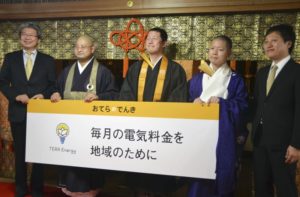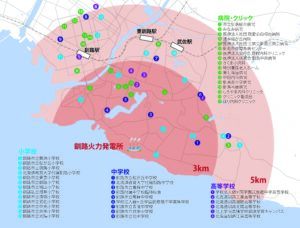(English follows Japanese)
東京インターンのシモン、テイラー、武田、篠崎です。
実は2月から聖心女子大学で特別展示企画、「気候変動へ挑むー私達にできること」を行なっていたのですが、新型コロナウィルスの影響で展示はしばらく中止となってしまいました。しかし、展示が中止になっても多くの方々に見て頂きたいという想いでデジタル形式の展示を作りました!
せっかくデジタル展示を見て頂けるのならもっと詳しく説明をできたらいいな、また、私達インターン生の展示への想いなども伝わったら嬉しいと思いこのブログを書かせて頂きました。少し長いのですが、ぜひ読んでみてください。
展示内容の要約
進む気候変動、地球はもはや限界に
展示は気候変動のタイムラインで始まります。産業革命は 1700年代後半に英国からはじまり、ヨーロッパ、北アメリカ、そしてアジアの一部へと広がっていき、産業革命をきっかけに世界は農業中心の経済から、化石燃料に依存した工業中心の経済へと変化していきました。19世紀になり地球大気を研究している科学者により新事実が発見されます。1824年、フランスの数学者・物理学者のジャン・バティスト・ジョゼフ・フーリエは世界で初めて「温室効果」について言及し、1861年、アイルランドの物理学者ジョン・ティンダルは、「温室効果」とCO2を含む特定の温室効果ガスのつながりを発見しました。1890年代にはスウェーデンの化学者スヴァンテ・アレニウスが初めてCO2の地球温度への影響を数字で表しました。
そして続く20世紀、着実に悪くなる気候変動の影響に対しての世界の反応が目立つ様になってきます。1970年4月22日に初めてアースデイが行なわれ、健康的で持続可能な環境を求めて2000万人以上の人々が米国中から結集しました。そして、70代以降から様々な組織や条約が結ばれ始めますーー例えば1988年の気候変動に関する政府間パネル(IPCC)や1997年の京都議定書。2015年には、パリ協定が合意され、産業革命前の水準と比較して世界の平均気温上昇を「1.5~2度未満」に抑えることが世界の目標となりました。しかし、人類が気候変動に気づいてからもう約200年が経つにも関わらず、行動し始めたのは最近のことであり、目標を達成するには不十分です。
気候変動の影響は以前よりも明白であり悪化しています。オーストラリアでは大幅な生物多様性の喪失などの原因になった森林火災が2019年9月から続き、中国をはじめとする多くの国では大気汚染が健康被害をもたらしています。日本においても気候変動の影響は深刻です。沖縄にある国内最大のサンゴ礁の97%が白化しています(2016年時点)。また、2018年7月23日には、埼玉県熊谷市で41.1度という観測史上最高気温が記録されました。2019年8月、九州北部が記録的な大雨に見舞われて、佐賀鉄工所から約11万リットルの油が流出し、東日本は2019年10月に台風19号により大きな被害を被りました。
日本の対策、石炭火力推進で世界に大きな遅れ
日本のCO2排出量は世界5位です。日々悪化する気候変動の影響に対して日本の対策は非常に遅れています。この数年で排出量は減少しましたが、2050年までにCO2排出ゼロという目標を達成するにはまだ対策は不十分です。日本での主なCO2排出の原因は交通、石炭火力発電(他の国に反して、日本はまだ石炭火力を推進しています)、製鉄、食品産業です。
行動しよう!
ここでは、気候変動問題の危機を理解し、皆さんの中で「何かが変わらなければいけない」という思いが芽生えたのではないでしょうか。そこでこの展示では、問題提起するだけではなく、一人一人が明日から出来る気候変動対策を紹介しています。
アクションは大きく2つの種類に分けられます。
一つは個人が行うことで得られる変化。パワーシフトやダイベストメント、そして食といった、私生活における行動を変えることで個々の気候変動への負担を減らす行為。もう一つはマーチに参加したり署名に協力する等が挙げられる、社会的に大きな変化を起こすための準備のようなもの。様々な形で私たちは気候変動に立ち向かっていかなければいけないのです。
展示パネルでは、すぐにインターネットで検索出来るように「検索ワード」を紹介しています。初耳のアクションでも、簡単に必要な情報が手に入る時代ですから、スマホやパソコンで調べてみて下さい。
気候変動は、政府や企業のみの問題ではありません。私たちが市民として声を上げ、変化を起こすことがこの問題に立ち向かうために必要不可欠であると言えます。
まずは1個から。様々なアクションパネルの中から、一つ行動を起こしてみましょう。気候変動問題は、解決できるはずです。
展示が出来上がるまで
ここからは展示が出来上がるまでの期間中の活動について話したいと思います。
聖心女子大学での展示、「気候変動へ挑むー私達にできること」はスタッフの方々に沢山助けて頂きながらインターン生が中心となって行いました。
まず、最初に行なった作業は展示内容の大枠組みを決めるためのブレインストーミング。
初めはインターン生一人一人のアイデアが漠然としていて展示内容を決めるのにも一苦労。展示場所が大学であるにも関わらず、展示期間は春休み中であるためどうしたら沢山の人に興味を抱いてもらい、展示を見に来て頂けるのか。ただ展示をしている事実だけを残すのだけでなく、気候変動問題を詳しく知らない人や、問題に対してどう行動を取ったらいいか分からない人など年代問わず多くの世代にどうメッセージを残すかを考え、展示内容及び特別イベントを考えました。
次に行なったのはタペストリーとパネル1個1個の内容決めと実際の制作。この段階での作業に一番時間がかかりました。気候変動問題は非常に複雑なため理解しづらいという問題があります。しかし、パネルが情報過多だと余計に理解しづらいと考え、シンプルで見やすく、重要な情報だけを載せたパネル作りを意識しました。特にスタッフの平田さんには簡潔なパネルになるまで沢山添削をして頂きました。タペストリー2枚、と約30枚のパネルは全て自分たちで制作を行いました。また、文章だけでなくグラフの作成やタペストリーのデザインも行ないました。三つ目の壁に展示しているアクションを促すためのパネルはインターネットで検索をかけてすぐに行なえるアクションからマーチに参加するなど少し大胆なアクションまで、出来る事は想像よりずっと多くそんなに難しくないという想いを込めて制作しました。
コロナウィルスの影響で無くなりましたが、展示作りと同時にイベントの計画も立てました。クライメートリアリティでトレーニングを受けたトレーニーによるプレゼン企画や映像を見て問題をより身近に感じてもらえる映画鑑賞の企画など、多くの方々に協力を頂き特別展示「気候変動へ挑むー私達にできること」は完成しました。
コメント
この展示は、人と一つのものを作ることの面白さや大変さを学ばせてくれるものとなりました。展示の具体的な内容が決まっていない中、皆がそれぞれ頭の中でイメージしている展示を形にするためには、意見をぶつけ合うのではなく、尊重し合うことで一人一人が持つベストなアイデアを集めて、より良いものに仕上がると感じました。固定概念に囚われたままでは新しいものは生み出されず、他者の考えを受け入れてこそ初めて共同作業に価値があるのではないでしょうか。ーテイラー
この展示を作ることはインターンとしての最初の仕事の一つでした。展示の内容や実施により責任や自分のアイディアを出せる自由性を頂けてとても興奮しました。たまに難しくて挑戦的な仕事だったけどとても楽しくて、クリエティブで、良い経験でした。たくさん勉強になりました。たくさんの人が私たちが作った展示のバーチャル版を見て、私達が楽しんで作ったように楽しんで見て頂ければ嬉しいです。ーシモン
展示のお話を聞いた時には正直混乱気味でしたが、話し合いを重ね、展示物の作成に取り組んでいました。常に展示を見てくれる方の視点に立って、インパクトのある写真選びや見やすいグラフのデザイン・グラデーションにすることなどは本当に大変な作業でした。最終的にはインターン生と平田さんとの素晴らしい協力のおかげで、このような展示を完成させられたこと、そしてこの展示に関わらせていただけたことに感謝しています。ー篠崎
このプロジェクトは私がインターン生として気候ネットワークで働き始めて初めての大きい作業でした。週に1、2回と限られた時間内でしか合わない仲間やスタッフの皆様方と連絡を取りながら制作を行なうのは想像以上に難しく、しかし、成長できる経験でした。多くの人に協力しながら一生懸命制作した展示を見て頂けたら嬉しいです。ー武田
This is Simone, Kianu, Yuko and Yu, all interns at the Kiko Network Tokyo office.
We were actually supposed to be having a special exhibit at the University of the Sacred Heart, titled “Challenging the Climate Crisis — What We Can Do.” However, due to the spread of COVID-19, our exhibit was unfortunately put on hold for some time. Since we still wanted a lot of people to be able to see our exhibit, we created a digital version of it!
This blogpost serves as a more detailed explanation for all the people kindly looking at our exhibit, and also as a way for us interns to say some of the things and thoughts we wanted to express and achieve through this exhibit. It’s a little long, but we hope you still give it a read.
Accelerating Climate Change, Close to Reaching Tipping Point
Our exhibit begins with a timeline of climate change. In the late 1700s, the Industrial Revolution transformed first Britain, then Europe, then North America, Asia and the rest of the world from agriculture-based economies into industrial ones highly reliant on fossil fuels. Over the 1800s, we see a number of breakthroughs of scientists researching our planet's atmosphere. In 1824, French mathematician and physicist Jean Baptiste Fourier makes the first reference to what we call today the "greenhouse effect". In 1861, Irish physicist John Tyndall discovers a link between said "greenhouse effect" and certain heat-trapping gases, including CO2. In the 1890s, Swedish chemist Svante Arrhenius tries to put a numerical value to the impact of CO2 on global temperature.
In the 1900s then, we see concrete reactions to the ever-worsening effects of climate change. On April 22nd 1970, the first Earth Day celebration mobilizes more than 20 million people all over the US protesting for a healthy and sustainable environment. Starting from the 70s, countless environmental organizations and treaties start to surface — the IPCC in 1988, for instance, or the Kyoto Protocol in 1997. In 2015, the Paris Agreement is agreed, uniting all UN nations under the goal of limiting global temperature rise to 1.5 or "well below 2°C above pre-industrial levels". One rather disappointing take away from this timeline: Despite the first signs of climate change emerging already roughly 200 years ago, we have only recently started to really take action, though perhaps not fast enough.
The impacts of climate change are now more evident and severe than ever. Australia has been plagued by horrible bushfires since September 2019, losing a lot of land and species. In China and other countries, air pollution is leading to serious health impacts. Japan too is gravely affected by climate change. In Okinawa, 97% of its largest coral reef has bleached. On July 23rd 2018 Kugayama in Saitama recorded its highest temperature, 41.1°C. In August of 2019, Kyushu was hit by record rainfall, causing a massive oil leak. In October of 2019, Typhoon Haggis massively damaged parts of Eastern Japan.
Japan's Response — Lagging Behind with Coal Power Promotion
Japan’s response to the steadily worsening impacts of climate change is slow. Japan ranks 5th globally in terms of CO2 emissions, and while they have decreased over the past years, the ideal goal of zero emissions in 2050 is still far away. Significant sources of CO2 emissions in Japan is the transportation sector, coal-fired power plants (which, contrary to the rest of the world, Japan is still promoting), iron manufacturing, and food.
Act Now!
At this point, you might have already understood the significance of the climate change issue, and wondering “something has to be changed”. That is why at this exhibit, we also present not only the issues themselves, but also the actions we each and every one of us can start taking from tomorrow.
There are mainly two types of actions that can be taken.
First is where you can make a small but meaningful difference by individuals. Powershift, divestment, and diet are some of the examples, where you can reduce your impact towards climate change by changing your daily behavior. Second is like a preparation for a major change in society, such as attending climate strikes and signing a petition. We must fight against this issue from multiple dimensions.
In the panels, we have included suggested “search words” so that you can easily find relevant information on the web. While you may never heard of these actions, please spend a few minutes to find out what you can do to make a difference.
Climate change is not an issue only for governments and companies. Citizens must raise their voice, and making a difference in our society is an essential component to solve the issue.
Start by one easy action. Choose one from the action panels, and take a step. Climate change can be solved.
The Process of Creating The Exhibit
“Challenging the Climate Crisis - What We Can Do” is an exhibit mainly created by the interns with help from staff at kikonetwork.
The first step we took in order to create the exhibit was brainstorming our ideas. It took us a long time to first decide on the topic of our exhibit since we only had vague ideas on what we wanted to do. We had a lot to consider, such as how we are going to gather people to come see the exhibit and how to make people interested in the exhibit, since the exhibit takes place at a college during spring break when there are no students. We wanted to create an exhibit that will give messages and leave impacts on people who came to the exhibit. Also, we wanted the exhibit to become one of the reasons for those who came to the exhibit to take an action to challenge the climate crisis.
After deciding on the topic of the exhibit, we decided on the content of panels and tapestry. This step took the longest. We determined themes for each wall, and set the panel contents according to the themes.The problem of climate change is so complex that it is difficult to understand. Thus, we attempted to create panels that are simple, easy to read, and contained only important information because it would make the climate crisis more complicated to understand if the panel had a glut of information. Ms. Hirata, one of the staff at kiko network, helped us to create our panels concisely. We designed and created the graphs of all of the tapestries(2) and panels(30) at the exhibit. We created the panels on the third wall, hoping that it will give ideas that it is a lot easier than they imagine to take actions. The actions we introduced are from actions that can be done immediately such as searching on the Internet to a little bolder action such as joining a march.
Although, they were cancelled due to the situation of coronavirus, we also planned some events such as presentations done by trainees from Climate Reality and Screening events.
Comments
I learned how interesting and difficult it is to create one thing with others. I felt that by respecting each other’s ideas rather than having to confront each other we will be able to create something better, especially when the specific contents of the exhibit are not decided yet. New things cannot be created if you are stuck in stereotypes, and it is only if you accept the ideas of others that collaboration is worthwhile. ー Kianu
Helping with the creation of this exhibit was among my first tasks as an intern at Kiko Network. I was really excited to be given more responsibility and some freedom to express my own ideas for the content and implementation of the exhibit. It was definitely challenging, but also very fun, creative, and a great experience. I definitely learned a lot. I would love for as many people as possible to check out the digital version of our exhibit and enjoy looking at it as much as we enjoyed making it. ー Simone
When I found out about the exhibit’s plan for the first time, honestly, I was confused. But we discussed lots and worked together on the creation of this exhibit. It was challenging for me to choose the best pictures with huge impact and to create easily visible graphs and gradations while considering our exhibit’s viewers. In the end, this exhibit was completed thanks to the united efforts of our interns and Hirata-san. I appreciate to have been involved in this project. ーYu
This project was one of the first projects I helped with since I started working at Kiko network as an intern. I was able to learn a lot from the process of making this exhibit, especially because we would only see each other once to twice a week. Now that the exhibit is in a digital form, I hope the exhibit will be viewed by a lot of people. ーYuko
この記事を書いた人

- 気候ネットワークに所属されていた方々、インターンの方々が執筆者となっております。
最新の投稿
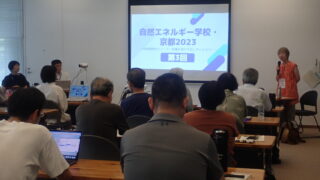 インターンの声2024年1月31日インターン生によるブログリレー第3弾~様々な体験を得られた8か月~
インターンの声2024年1月31日インターン生によるブログリレー第3弾~様々な体験を得られた8か月~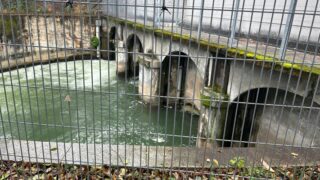 インターンの声2024年1月22日蹴上発電所の見学会に参加してきました!
インターンの声2024年1月22日蹴上発電所の見学会に参加してきました! インターンの声2023年12月28日インターン生によるブログリレー第2弾~地域も日本も世界も知れた8ヵ月~
インターンの声2023年12月28日インターン生によるブログリレー第2弾~地域も日本も世界も知れた8ヵ月~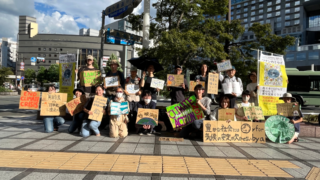 インターンの声2023年11月30日インターン生によるブログリレー第1弾~スタンディング・気候マーチに参加して~
インターンの声2023年11月30日インターン生によるブログリレー第1弾~スタンディング・気候マーチに参加して~
